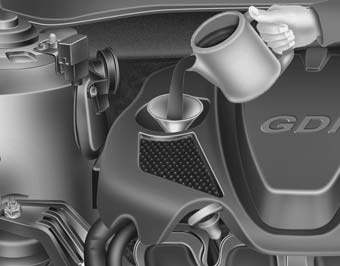Checking the engine oil level

1. Be sure the vehicle is on level ground.
2. Start the engine and allow it to reach normal operating temperature.
3. Turn the engine off and wait for a few minutes (about 5 minutes) for the oil to return to the oil pan.
4. Pull the dipstick out, wipe it clean, and re-insert it fully.
5. Pull the dipstick out again and check the level. The level should be between F and L.
CAUTION
Do not overfill with engine oil. Engine damage may result.

If it is near or at L, add enough oil to bring the level to F. Do not overfill.
Use a funnel to help prevent oil from being spilled on engine components.
Use only the specified engine oil. (Refer to “Recommended lubricants and capacities” in section 8.)
See also:
Child Restraint System
Children riding in the car should sit in the rear seat and must always be properly
restrained to minimize the risk of injury in an accident, sudden stop or sudden
maneuver. According to accident s ...
TACHOMETER
The tachometer registers the speed of your engine in revolutions per minute (rpm).
CAUTION:
The engine should not be increased to such a speed that the needle enters
the red zone on the tachomet ...
Child-protector rear door lock
The child safety lock is provided to help prevent children from accidentally
opening the rear doors from inside the vehicle. The rear door safety locks should
be used whenever children are in th ...


